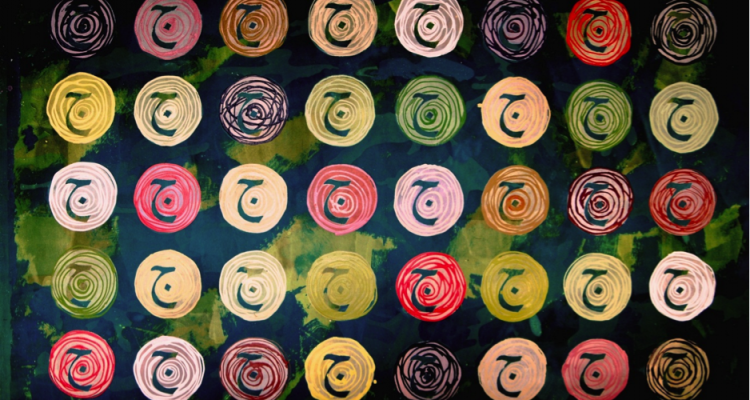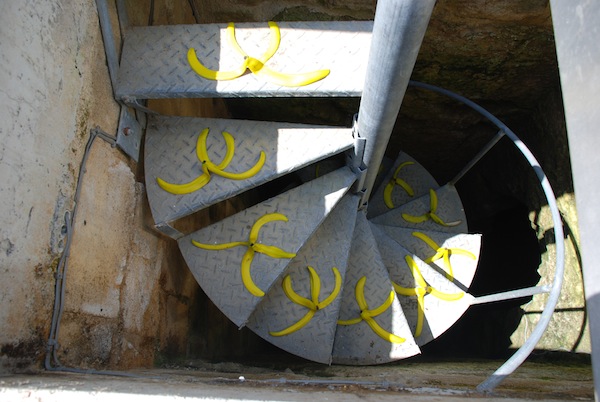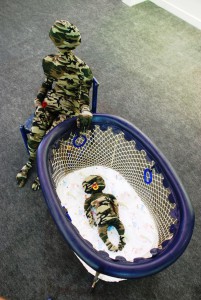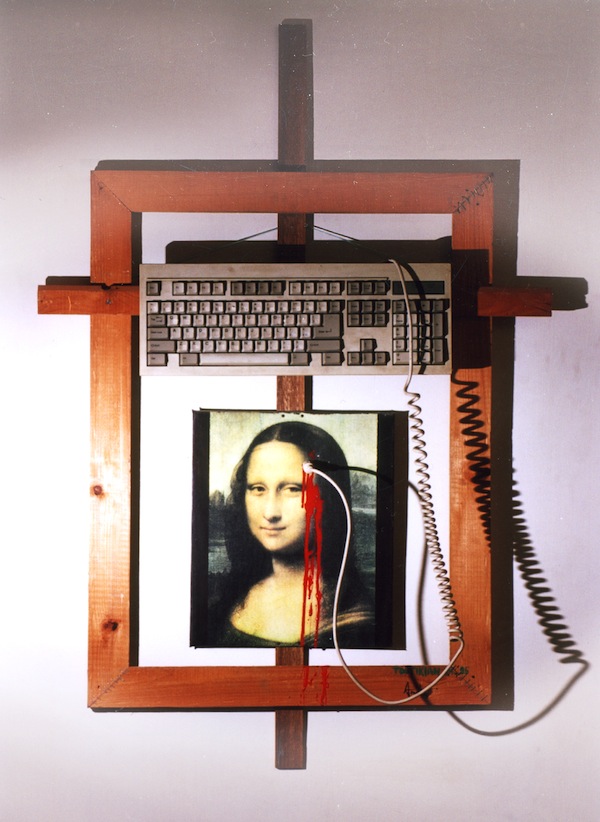 Anita Toutikian, Moshabbak ( (مشـبّك: Tangled Sweets – 2011
Two Dimensional Installation on Canvas 262 x 168 cm
Anita Toutikian, Moshabbak ( (مشـبّك: Tangled Sweets – 2011
Two Dimensional Installation on Canvas 262 x 168 cm
Perceptual blindness is a psychological condition, meaning, if the brain cannot recognize, acknowledge or process something, the eye cannot see it. The Lebanese were perceptually blind about the imminent “Civil War”, they never called it war, they called it “Al-ahdath or الاحداث” meaning “The events” or “the incidents”. The whole world had agreed to solve the Middle East problem at the expense of young and tiny Lebanon. By the time the cake was on the table everybody had knives and forks. Fifteen years of destruction and bloodshed followed, no one won. Even today, it is painful to write these words.

Anita Toutikian, The Field of Hearts, 2006, Interactive Installation with firecracker stuffed chocolates on the walls and floors, Inverterted Lebanese flag with Calligriphized English,Photo taken at Espace SD, Beirut 2006
We do not have comprehensive documentation about wartime artworks. Art was a recent phenomenon by then, a mystery, people didn’t quite understand it, or feel it, many just looked and waited for a connoisseur to release a verdict about it. People understood art as decoration, craftsmanship, and the exercise of being “cultured” by appropriating western lifestyle, and war was not a generally accepted theme in art. Being artistically sensitive and at a distance from the battlefield, Armenian artists were the first to react to war and paint it. One of them painted the famous bus incident soon after it happened; I have personally seen this painting, another one painted the dead on the streets. I was told that Bachir Gemayel, the assassinated president, visited their show. These artists are forgotten today because their art was not the mainstream.
Armenians are a nation without childhood, kids did not grow hearing fairytales, they were raised with inter-generationally transmitted images of genocide. The past was so overwhelming that I thought all the kids of the world listened to horror stories from grandparents. In my child-mind, testaments of 1915 brutal killings came and blended into the “incidents” of 1938, 1948, 1958, 1968 and 1975 in perfect continuum. As a teen, I hated the war because my father, whose Arabic was weak, made me watch evening TV news and translate to him. It was a daily ordeal for both of us, I wanted to break free of this nauseating task, but he, poor man, like most Lebanese of his time, sincerely wanted to know why the war was happening.

Anita Toutikian, I Came I Saw I Fell, 1996 Contraceptual Art with oil painting, Frame, stencil print on back of canvas, 120 x 150 cm. Photo taken at the Sursock Museum, Beirut 1996
Art was not a word in our vocabulary. As a kid, I was punished for scribbling on walls, or for tearing people out of my dad’s fashion magazines, those were my toys and my friends. We never had art class at school. I made my first spontaneous drawings as an adult without any know-how. I wanted to learn more, but during the war, it was hard to find schools, books, and above all information. I gradually built a solitary and fantasy relationship with art. I studied like a fanatic, in shelters, in candlelight, in obsolete books, in ad-hoc academies, and in total ignorance. I didn’t know that I was denying the war with art. Denial is the first psychological reaction to loss and trauma. The fantasy ended when I saw a real Lebanese art show for the first time. It was a disaster, it fell too short of my giant imagination. The collapse of art in my soul felt even worse than my grandparents’ stories and the ugly images of war combined. It was as if someone told me “voila madam, meet Jesus” and I would look at a young man in jeans. Art was an opaque container of the past that broke splashing accumulated Anger. Anger is the second psychological reaction to loss and trauma.
For the next ten years, 1991-2001, I worked frantically with no foundation, no theory, no objective, no boundaries, no expectations, and no need for anyone’s approval; only instinct. My work looked wrong, most of my work of that time is lost without documentation, because even I didn’t think of them as art, I was just having irresponsible fun. All I hoped for was a corner at a regular art show to display my “work”, and to invite a consequent shower of criticism and hostile advice. Sometimes I couldn’t get a corner, but I still would drop my work there, all it took was a paper to post somewhere. I signed my name “artist unknown” to avoid inquisitive people, because I had no words to explain what I was doing. Frequently cleaners would throw my work, video reporters would never include them in their footage, most people, perceptually blind, did not even notice them. One psychiatrist sent me a note saying: “if you need mental help, I can provide it to you.” It was a long and unconscious session of cultural exorcism, of purging intellectual debris. It was the end of mental obedience.
My earliest works were fabricated stories posted here and there; I was reconstructing my own belief system about art. Short texts, found objects, assemblages, interactions, counteractions and interruptions followed. Breaking mental habits of people became my cause and my passion. People told me that I was a conceptual artist, or an installation artist, these were new words for me, and I was none of those, I was an intervention/interruption artist, I was interrupting static thinking and perceptual blindness on all possible levels, and I didn’t want to be identified by the medium I used. Art was not about what I showed, it was about how people interacted with it, and how it changed their perception of art, life and hopefully politics. Unconsciously, I was transmitting my shock moment onto onlookers; “Do not let someone else think for you” was my message.

Anita Toutikian, Balance of Powers, 2004. Installation with wood, plexiglas, dough pin and dough men, iron scales. Variable dimensions. Photo taken at the Museum of Modern Art Algiers 2007
Although interactivity characterized my work, my purpose was to encourage people to develop opinion and express it instead of waiting for someone to think for them. I wanted to put art in relation with people as opposed to it being a disconnected object of adoration. I wanted people to contribute in the making of art, manually and intellectually, I provided pens and papers asking them to express their like or dislike. I gave them the chance to touch, remake and play with the previously untouchable artworks for the first time; even exhibition curators could not tolerate the idea. I wanted to demystify art and push its boundaries. I swapped the roles of artist and spectator and I even gave them prizes. I wanted to empower viewers rather than dominate them. Anything was good except the blank staring.

Anita Toutikian, Immortality, 2009. Interactive Installation inside prehistoric underground tomb from 500 BC, banana peels and iron staircase. Variable dimensions. Photo taken at Artos Foundation, Nicosia, 2009
Times improved, I received prizes, I was invited to exhibits, and my name appeared in magazines, things I would never imagine at the beginning. People called me saying: “Anita, I got a broken chair to throw, do you want it?” I am so grateful that I lived this authentic moment in history at its best; pure, wild, carefree, effortless and undercover.

Anita Toutikian, Culture Cookies, 2009, Interactive installation with paper cupcakes, blades, candies, teabags, metal meter, paper text, Photo taken at Artos Foundation, Nicosia
People think that artists who live the war can automatically express it in picturesque ways. That is not true. If that were true, all war generation artists would paint it. Usually it is the opposite; artists tend to guess and express others’ expectations, which sometimes serve political ends. For example, the 9/11 event invited international attention into the Middle East and its art; naturally artists liked this attention and they, mostly artists who never lived the war, excavated war images from the fossilized past, as expected. War was glorified and its icons became instant fetish. It is funny how suddenly jack pops out of the box, at the right moment, to paint sensation on demand. The function of this kind of art is to justify others’ perception of us; it is like saying: “I am what you know about me”. That was too colonialist, too orientalist, too voyeuristic and severely lacking a convincing narrative.

Anita Toutikian, Damnesia, 2011, Installation detail: Military camouflage patterned stuffed dolls, plastic and metal crib, cloth, wood chair, paper flower, plastic pacifier, Photo taken at MENASART Fair, Beirut 2011
I am not what you know about me. As much as I am a counteractive artist, I am also hyperconscious about medium, technique, form and theory. Theory is a dangerous word; it is good when it helps digest thorny ideas, but it can also instigate desired behaviors, and frequently becomes a curtain that blocks sight. With each work, I have erased a theory to rewrite a new one. New message always takes new form of expression, and new form makes theory. My reaction to 9/11 was sending a prize to a President in 2002, my version of fundamentalism was a solo show with one single letter of the Phoenician alphabet. Figurative installation and liquid drawing in military camouflage was my vehicle to make a statement about what was later called the Arab Spring. All those years I never wanted to use the Lebanese war as my subject, but in retrospect, I clearly see that the war always found its way into my work in so many unsuspecting ways; like in my bleeding Joconda, in my firecracker stuffed chocolates, in my blender bra, in my culture cookies in the dough-men, and in the prehistoric tomb, just to name a few.

Anita Toutikian, The Beginning of the End, 1994, Assemblage with Keyboard, wood, print, acrylic paint, 110 X 77 cm
Nowadays, I am digging graves. I am using my grandmother’s embroidery (the art of stitching borders) as my platform; I call it Exbroidery. Thematically, Exbroidery is about extracting psychoanalytical information from old embroidery pieces, but theoretically, it is another milestone in extending artistic logic and practice. Art starts an intellectual adventure and becomes a collective prayer, yet part of me always wants to be in the wild, lost outside the comfortable placenta of established values and norms. Because ultimately, art is about the ability of the artist to shake perceptual blindness, and to interrupt mental routine about the known world. The rest is everyday newspaper headlines.